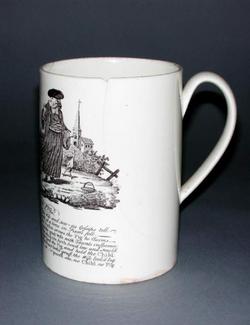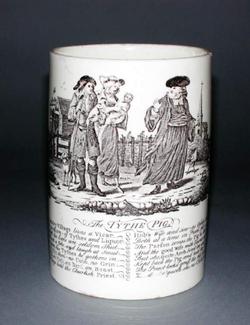Current Location: In storage
Titles
The Tythe Pig
Maker(s)
Factory:
Unidentified Staffordshire factory
(Possibly)
Factory:
Unidentified Liverpool factory
(Possibly)
Entities
Categories
Description
Lead-glazed creamware transfer-printed in black with ‘The Tythe Pig’ and accompanying verse.
Cream-coloured earthenware, lead-glazed and transfer-printed onglaze in black using the glue bat method. The cylindrical mug has a loop handle. Opposite the handle is a print a man and woman standing together in front of farm buildings. The man has a dog by his side and holds a stick in his right hand and a pig in his left. The woman holds a small child. Turning away from the couple is a vicar. Beside him is a peacock and behind him a church. In front of the figures are sheaves of wheat, apples, pears and baskets of fruit. Beneath the image are the title - ‘The TYTHE PIG’ - and a verse divided into two columns. The first column reads: ‘In Country Village lives a Vicar / Fond – as all are - of Tythes and Liquor; / To Mirth his Ears are seldom shut, / He’ll Crack a Joke, and laugh at smut, / But when he Tythes he gathers in, / True Parson then - no Coin, no Grin; / On Fish, on Flesh, on Bird, on Beast, / Alike lays hold the Chulish Priest.’ The second column reads: ‘Hob’s Wife and sow – as Gossips tell / Both at a time in Pieces fell; / The Parson comes, the Pig he claims, / And the Good Wife with Taunts inflames; / But she, quite Arch, bow’d low and smil’d, / Kept back the Pig, and held the Child; / The Priest look’d gruff, the Wife look’d big, / Z…d Sir! quoth she, no Child, no Pig.’
Notes
History note: Provenance unknown before William Turner, Esq., Purley Chase, Atherstone, Warwickshire; Turner sold to Mr Stoner, London, who then sold for £3 on 14 March 1911 to Dr J.W.L. Glaisher, FRS, Trinity College, Cambridge
Legal notes
Dr J.W.L. Glaisher Bequest.
Measurements and weight
Height: 15 cm
Width: 15 cm
Acquisition and important dates
Method of acquisition: Bequeathed
(1928-12-07)
by
Glaisher, J. W. L., Dr
Dating
18th Century, Late
George III
Circa
1780
CE
-
Circa
1790
CE
Note
The transfer print on the jug is derived from a print published in London in 1751, drawn by Louis Phillipe Boitard and engraved by Johann Sebastian Müller. Although the print on the jug varies a few of the details of Boitard’s image, such as the buildings in the background, the inscription beneath is copied exactly. Boitard’s print was designed as a satire of the greed of the clergy. The print and inscription describe a not-so-pious parson who enjoys drink and smutty jokes and gets his comeuppance when he comes to claim a pig as tythe from a farmer’s wife: she insists that if he wants the pig, he must also take her child; the parson then turns away in distaste. The ‘Tythe Pig’ print was very popular throughout the second half of the 18th-century, a time when satirical and humorous prints were an common form of entertainment; some print-makers even published sequels to it, showing the greedy parson returning to try and claim the pig again, only to be outfoxed by the sow herself!
Transfer printing was introduced to English pottery in the second half of the 18th century. Most early transfer-printed ware used the glue bat method. In this method, the design was engraved on a copper plate, which was then covered with linseed oil. The thin bat of animal glue was pressed onto the oiled plate and then applied to the ware. Once the bat was removed, the ware was dusted with powdered metallic oxide, which adhered to the oil, and fired to fix the design. This method was common for round-bodied vessels like this mug because the flexible glue bat can easily stretch round curving body.
Components of the work
Base
Diameter 10.5 cm
Body
Materials used in production
black
Ceramic printing colour
cream coloured
Earthenware
Lead-glaze
Techniques used in production
Transfer printing
Lead-glazing
Inscription or legends present
- Text: “The TYTHE PIG”
- Location: Under the image on the front of the mug
- Method of creation: Transfer-printed onglaze in black
- Type: Inscription
- Text: In Country Village lives a Vicar / Fond - as all are - of Tythes and Liquor; / To Mirth his Ears are seldom shut, / He’ll Crack a Joke, and laugh at smut, / But when he Tythes he gathers in, / True Parson then - no Coin, no Grin; / On Fish, on Flesh, on Bird, on Beast, / Alike lays hold the Chulish Priest. / Hob’s Wife and sow - as Gossips tell / Both at a time in Pieces fell; / The Parson comes, the Pig he claims, / And the Good Wife with Taunts inflames; / But she, quite Arch, bow’d low and smil’d, / Kept back the Pig, and held the Child; / The Priest look’d gruff, the Wife look’d big, / Z…d Sir! quoth she, no Child, no Pig.
- Location: Under the image on the front of the mug
- Method of creation: Transfer-printed onglaze in black
- Type: Inscription
Inscription present: stick-on octagonal white paper stick on label with red border
- Text: No 3382 Large mug of Leeds/cream ware with/picture ‘The Tythe/Pig’ and verses. From the W. Turner/Collection. b. March 14, 1911.
- Location: On base
- Method of creation: Handwritten in black ink
- Type: Label
References and bibliographic entries
Identification numbers
Accession number: C.735-1928
Primary reference Number: 75950
Old catalogue number: 3382
Stable URI
Audit data
Created: Saturday 6 August 2011
Updated: Tuesday 30 April 2024
Last processed: Tuesday 15 July 2025
Associated departments & institutions
Owner or interested party:
The Fitzwilliam Museum
Associated department:
Applied Arts






